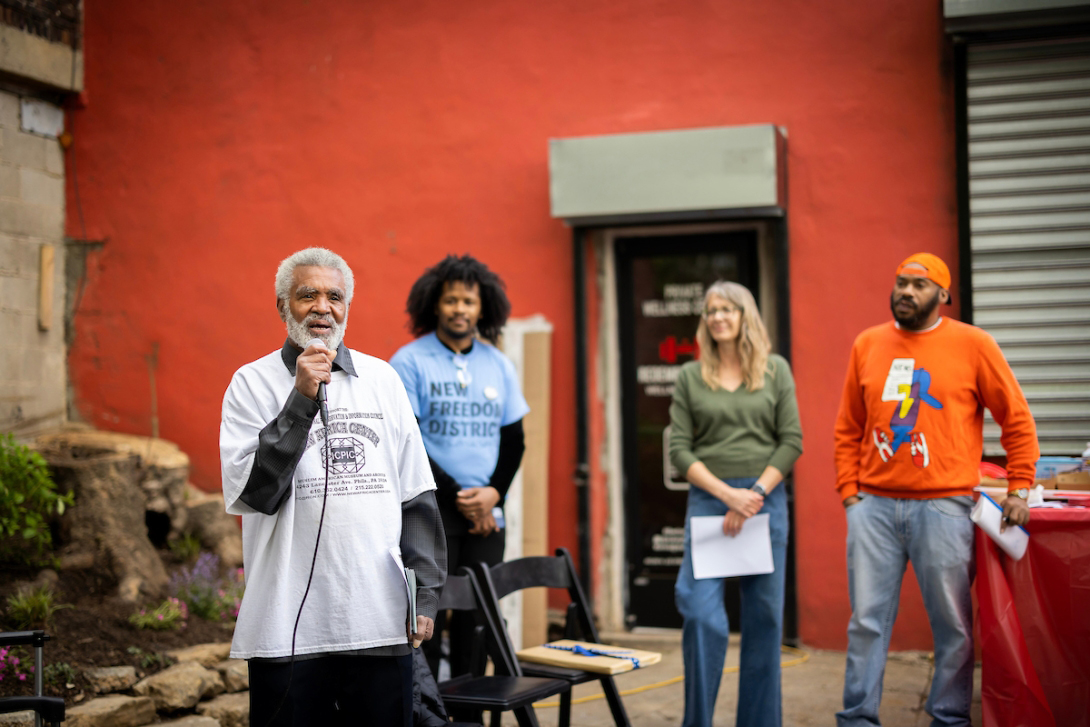The Stuart Weitzman School of Design’s first design-build studio this spring was the culmination of an effort coordinated by PennPraxis and supported by the departments to foster collaboration with West Philly community members.
The spring 2023 studio, led by alums David Seiter and Aaron Booher, who head the New York City landscape design firm Future Green Studio, was offered as part of the Weitzman School’s Studio+ initiative.
The studio built on the work of last year’s Studio+, in which graduate students from Weitzman and local public school students worked together to design and build “The Porch,” a stage and garden for West Philadelphia High School, over 15 months. The Spring 2023 studio also built on a course led last spring by Weitzman’s director of Justice & Belonging, Matt Kenyatta, which focused on building the identity of a Black cultural district in a part of West Philly that straddles Lancaster Avenue. But it came with an aggressive timeline for a design-build studio, with site selection, community engagement, design, and construction all taking place in the course of a single semester.
The spring studio, which Booher and Seiter led with Future Green staff designers Anni Pan and Farasha Zaman, was an exercise in “engaging with a local community, gathering stories and making spaces,” according to the syllabus. Students worked with community leaders and residents to develop a key site as a visible distillation (or embodiment) of the New Freedom District, an initiative focused on illuminating the Civil Rights heritage of the Lancaster Avenue corridor.
Lex Garden sits on an odd lot on Lex Street in West Philadelphia, next to Redemption Body Wellness Center. The ownership of the lot was complicated, says Chanju Yang, a dual-degree student in architecture and landscape architecture. Part of it was owned by the city, and part of it was owned by a homeowner in the rear of the property, part by a developer, and part by the gym owner. It took time to get all the right permissions in place to build the garden there, and the students were careful only to build structural elements on the parts of the lot where private owners had agreed to allow it. Yang says she was drawn to the studio because of the design-build aspect, but the most important charge was helping community members execute their own vision.
“It was about giving a place for the community that they can be proud of and that they can cherish. This is a place that has a long history,” Yang says.
Yang worked on the landscape design and grading. Others selected plants, designed furniture, built the pergola, and worked through budget constraints. Students helped coordinate two community engagement sessions with West Philly residents in February and March. Funding for materials came from PennPraxis and the Weitzman School. Audrey Genest, a landscape architecture student who graduated this spring, worked on the benches, with the aim of making something “buildable, affordable within our means, durable, sleek.”
The spirit of Studio+ has been strongly executed in its first two years, says Ellen Neises, professor of practice in landscape architecture and Lori Kanter Tritsch Executive Director of PennPraxis. The projects at West Philly High and the Lex Street Garden have united the Weitzman School’s various departments and nurtured relationships between the school and its surrounding neighborhoods. The single-semester design-build studio was an experiment that succeeded, Neises says. The next design-build Studio+ will run in Fall 2023, with the transformation of Sayre High School, which was awarded $100,000 from the University’s Projects for Progress fund.
“It’s a huge asset to the curriculum as a whole, because for many of our students, the process of converting drawings into built structures is really abstract,” Neises says. “It’s hard to be a good designer and think about specification of materials or strategies for working on a budget or designing for durability until you do it yourself. The students who built this garden seemed to have reached a deeper level of satisfaction by creating a place of lasting value in West Philadelphia. They made a lot of people happy with design (and shovels), and there was a lot of love and respect flowing their way.”
This story is by Jared Brey. Read more at Weitzman News.








